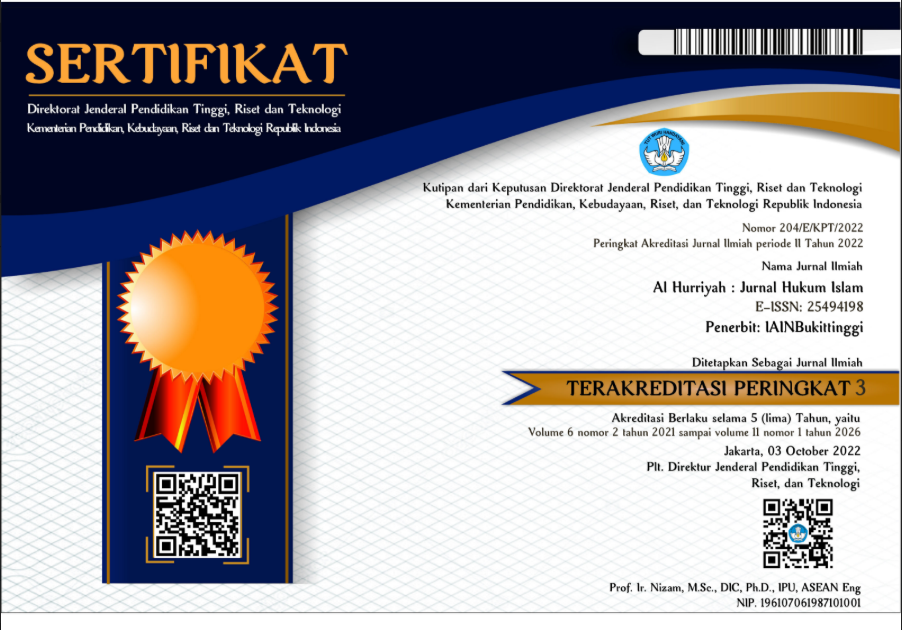Analysis of U.S. Geopolitical Impact on Taiwan’s Semiconductor Market through Sharia Principles
DOI:
https://doi.org/10.30983/al-hurriyah.v10i1.9253Keywords:
Us Geopolitics, Semiconductor Industry, Sharia EconomicsAbstract
The semiconductor industry in Taiwan, led by the Taiwan Semiconductor Manufacturing Company (TSMC), plays a strategic role in maintaining global technological and economic balance. Escalating geopolitical tensions between the United States and China have reshaped the dynamics of this industry, as the U.S. implements restrictive policies on semiconductor exports to China and promotes supply chain diversification through legislation such as the CHIPS and Science Act of 2022. This study aims to analyze the geopolitical impact of U.S. policies on Taiwan’s semiconductor market through the lens of Sharia economic principles, which emphasize justice (adl), balance (mizan), and the promotion of public welfare (maslahah). Employing a qualitative descriptive approach combined with a sociological legal method, the research collects data through in-depth interviews with semiconductor industry experts, scholars of international trade law, and Islamic economic theorists. Document analysis was also conducted on policy texts, Bureau of Industry and Security (BIS) reports, export control regulations, and relevant trade statistics from WSTS and SEMI. The findings reveal that while U.S. initiatives offer short-term advantages to Taiwan by enhancing technological security and global competitiveness, they also generate long-term vulnerabilities such as dependency risks, unequal market access, and potential ethical imbalances. Viewed through Sharia principles, these dynamics highlight the importance of fairness, mutual benefit, and sustainability in global trade governance. The study concludes that applying Islamic ethical frameworks can contribute to a more just and balanced semiconductor market in the evolving geopolitical order.
References
Akira, Yamaguchi. “The Impact of News Shock of the Openings or Expansions of Large-Scale Semiconductor Plants on Local Labour Market in Japan.” Japan and the World Economy 72 (December 2024): 101281. https://doi.org/10.1016/j.japwor.2024.101281.
Bui, Tat-Dat. “Assessing Sustainable Supply Chain Transparency Practices in Taiwan Semiconductor Industry: A Hierarchical Interdependence Approach.” International Journal of Production Economics 272 (June 2024): 109245. https://doi.org/10.1016/j.ijpe.2024.109245.
Carnabuci, Gianluca, Elisa Operti, and Balázs Kovács. “The Categorical Imperative and Structural Reproduction: Dynamics of Technological Entry in the Semiconductor Industry.” Organization Science 26, no. 6 (December 2015): 1734–51. https://doi.org/10.1287/orsc.2015.1011.
Chen, Tingchien, and Daniel Schiller. “The Role of Labour Market Intermediaries for Migrant Workers in Global Production Networks: The Example of Filipino Migrant Workers in the Taiwanese Semiconductor Industry.” Global Networks 25, no. 1 (January 2, 2025). https://doi.org/10.1111/glob.12499.
Chen, Tsung-chun, Dong-Qiang Guo, Hsiao-Min Chen, and Tzu-ti Wei. “Effects of R&D Intensity on Firm Performance in Taiwan’s Semiconductor Industry.” Economic Research-Ekonomska Istraživanja 32, no. 1 (January 1, 2019): 2377–92. https://doi.org/10.1080/1331677X.2019.1642776.
Chien, Chen-Fu, Yun-Siang Lin, and Sheng-Kai Lin. “Deep Reinforcement Learning for Selecting Demand Forecast Models to Empower Industry 3.5 and an Empirical Study for a Semiconductor Component Distributor.” International Journal of Production Research 58, no. 9 (May 2, 2020): 2784–2804. https://doi.org/10.1080/00207543.2020.1733125.
Chung, Park, and So Young Sohn. “Early Detection of Valuable Patents Using a Deep Learning Model: Case of Semiconductor Industry.” Technological Forecasting and Social Change 158 (September 2020): 120146. https://doi.org/10.1016/j.techfore.2020.120146.
Clark, Richard, Sarah Kreps, and Adi Rao. “The Political Economy of Reshoring: Evidence from the Semiconductor Industry.” Edited by Poowin Bunyavejchewin. PLOS ONE 20, no. 2 (February 14, 2025): e0316473. https://doi.org/10.1371/journal.pone.0316473.
Danilin, I., and Y. Selyanin. “Race for Nanometers: American Policy Toward Taiwan and Republic of Korea.” World Economy and International Relations 67, no. 11 (2023): 80–88. https://doi.org/10.20542/0131-2227-2023-67-11-80-88.
Danilin, Ivan V. “The U.S.-China Technological War.” Russia in Global Affairs 19, no. 4 (2021). https://doi.org/10.31278/1810-6374-2021-19-4-78-96.
Elia, Gianluca, Antonio Messeni Petruzzelli, and Andrea Urbinati. “Implementing Open Innovation through Virtual Brand Communities: A Case Study Analysis in the Semiconductor Industry.” Technological Forecasting and Social Change 155 (June 2020): 119994. https://doi.org/10.1016/j.techfore.2020.119994.
Faccin, Kadígia, Alsones Balestrin, Bibiana Volkmer Martins, and Claudia Cristina Bitencourt. “Knowledge-Based Dynamic Capabilities: A Joint R&D Project in the French Semiconductor Industry.” Journal of Knowledge Management 23, no. 3 (April 8, 2019): 439–65. https://doi.org/10.1108/JKM-04-2018-0233.
Frieske, Benjamin, and Sylvia Stieler. “The ‘Semiconductor Crisis’ as a Result of the COVID-19 Pandemic and Impacts on the Automotive Industry and Its Supply Chains.” World Electric Vehicle Journal 13, no. 10 (October 16, 2022): 189. https://doi.org/10.3390/wevj13100189.
Homberg, Michael. “Mensch / Mikrochip.” Vierteljahrshefte Für Zeitgeschichte 66, no. 2 (April 1, 2018): 267–93. https://doi.org/10.1515/vfzg-2018-0014.
Hsu, Liang-Ching, Ching-Yi Huang, Yen-Hsun Chuang, Ho-Wen Chen, Ya-Ting Chan, Heng Yi Teah, Tsan-Yao Chen, Chiung-Fen Chang, Yu-Ting Liu, and Yu-Min Tzou. “Accumulation of Heavy Metals and Trace Elements in Fluvial Sediments Received Effluents from Traditional and Semiconductor Industries.” Scientific Reports 6, no. 1 (September 29, 2016): 34250. https://doi.org/10.1038/srep34250.
Khakifirooz, Marzieh, Chen Fu Chien, and Ying-Jen Chen. “Bayesian Inference for Mining Semiconductor Manufacturing Big Data for Yield Enhancement and Smart Production to Empower Industry 4.0.” Applied Soft Computing 68 (July 2018): 990–99. https://doi.org/10.1016/j.asoc.2017.11.034.
Li, Hongkuan, Haiyan He, Jiefei Shan, and Jingjing Cai. “Innovation Efficiency of Semiconductor Industry in China: A New Framework Based on Generalized Three-Stage DEA Analysis.” Socio-Economic Planning Sciences 66 (June 2019): 136–48. https://doi.org/10.1016/j.seps.2018.07.007.
Liao, Shu-hsien, Da-chian Hu, Chih-Chiang Chen, and Yu-Lu Lin. “Comparison of Competing Models and Multi-Group Analysis of Organizational Culture, Knowledge Transfer, and Innovation Capability: An Empirical Study of the Taiwan Semiconductor Industry.” Knowledge Management Research & Practice 13, no. 3 (August 19, 2015): 248–60. https://doi.org/10.1057/kmrp.2013.46.
Liu, Cheyuan, Tao He, Fangzhou Liu, Shutao Liang, and Chunyu Zhang. “Trade Facilitation, Market Size, and Supply Chain Efficiency of Taiwan Semiconductor Companies.” Edited by Burak Erkayman. PLOS ONE 19, no. 10 (October 16, 2024): e0299322. https://doi.org/10.1371/journal.pone.0299322.
Loke, Beverley, and Ralf Emmers. “U.S.-China Great-Power Politics and Strategic Ambiguities in an Evolving Indo-Pacific Security Architecture.” Asia Policy 18, no. 4 (October 2023): 52–60. https://doi.org/10.1353/asp.2023.a911618.
Lu, Wen‐Min, Irene Wei Kiong Ting, Chien‐Heng Chou, and Sheng‐Hui Yao. “Assessing Innovation, Sustainability, and Market Performance in Taiwan’s Semiconductor Sector: Insights From ESG‐Driven Analysis.” Business Strategy and the Environment, February 11, 2025. https://doi.org/10.1002/bse.4195.
Luo, Ming, Heng-Chao Yan, Bin Hu, Jun-Hong Zhou, and Chee Khiang Pang. “A Data-Driven Two-Stage Maintenance Framework for Degradation Prediction in Semiconductor Manufacturing Industries.” Computers & Industrial Engineering 85 (July 2015): 414–22. https://doi.org/10.1016/j.cie.2015.04.008.
Monsees, Linda, and Daniel Lambach. “Digital Sovereignty, Geopolitical Imaginaries, and the Reproduction of European Identity.” European Security 31, no. 3 (July 3, 2022): 377–94. https://doi.org/10.1080/09662839.2022.2101883.
Muhammadi, Rahat Iqbal, and Hashim Ali. “Central Asia and the Great Power Politics: An Analysis of China’s National Interest in the Region and U.S. Approach to China.” The Chinese Historical Review 30, no. 2 (July 3, 2023): 228–40. https://doi.org/10.1080/1547402X.2023.2268883.
Park, Changhyun. “Market Entry Strategies in a High-Tech Successive Generations Market: A Case Study of Three Semiconductor Firms with Different Entry Modes.” Journal of Business & Industrial Marketing 35, no. 11 (April 1, 2020): 1751–66. https://doi.org/10.1108/JBIM-08-2019-0354.
Park, Changhyun, and Heesang Lee. “Early Stage Value Co-Creation Network – Business Relationships Connecting High-Tech B2B Actors and Resources: Taiwan Semiconductor Business Network Case.” Journal of Business & Industrial Marketing 33, no. 4 (May 8, 2018): 478–94. https://doi.org/10.1108/JBIM-09-2016-0211.
Peng, Yuxin. “Japan and South Korea’s Engagement in the Chinese Market Post-RCEP Implementation: A Case Study of the Semiconductor Industry.” Asia and the Global Economy 4, no. 2 (July 2024): 100085. https://doi.org/10.1016/j.aglobe.2024.100085.
Pimentel, André de Pieri, Isabela Vianna Pinho, Apoena Mano, and Anna Clara Pereira Soares. “A Escassez Dos Semicondutores e as Transformações Recentes Do Mercado Automotivo.” Tempo Social 35, no. 1 (April 28, 2023): 109–29. https://doi.org/10.11606/0103-2070.ts.2023.204348.
Qiu, Wenjie. “Systematic Risk Analysis of Semiconductor Global Market Based on Deep Feature Fusion K-Means Algorithm.” Edited by Jun Ye. Computational Intelligence and Neuroscience 2022 (September 29, 2022): 1–11. https://doi.org/10.1155/2022/8036956.
Ramani, Vinay, Debabrata Ghosh, and ManMohan S. Sodhi. “Understanding Systemic Disruption from the Covid-19-Induced Semiconductor Shortage for the Auto Industry.” Omega 113 (December 2022): 102720. https://doi.org/10.1016/j.omega.2022.102720.
Rasiah, Rajah, Rafat Beigpoor Shahrivar, and Xiao-Shan Yap. “Institutional Support, Innovation Capabilities and Exports: Evidence from the Semiconductor Industry in Taiwan.” Technological Forecasting and Social Change 109 (August 2016): 69–75. https://doi.org/10.1016/j.techfore.2016.05.015.
Shattuck, Thomas J. “Stuck in the Middle: Taiwan’s Semiconductor Industry, the U.S.-China Tech Fight, and Cross-Strait Stability.” Orbis 65, no. 1 (2021): 101–17. https://doi.org/10.1016/j.orbis.2020.11.005.
Sheng, Li. “Cyber-Politics in U.S.–China Relations: Big Tech and the Trade War,” 43–70. Springer, 2022. https://doi.org/10.1007/978-981-19-3682-1_2.
Shin, Namchul, Kenneth L. Kraemer, and Jason Dedrick. “R&D and Firm Performance in the Semiconductor Industry.” Industry and Innovation 24, no. 3 (April 3, 2017): 280–97. https://doi.org/10.1080/13662716.2016.1224708.
Steinmeister, Louis, and Markus Pauly. “Human vs. Machines: Who Wins in Semiconductor Market Forecasting?” Expert Systems with Applications 263 (March 2025): 125719. https://doi.org/10.1016/j.eswa.2024.125719.
Stricker, Nicole, Andreas Kuhnle, Roland Sturm, and Simon Friess. “Reinforcement Learning for Adaptive Order Dispatching in the Semiconductor Industry.” CIRP Annals 67, no. 1 (2018): 511–14. https://doi.org/10.1016/j.cirp.2018.04.041.
Teow, Yeit Haan, Yi Hui Chiah, Kah Chun Ho, and Ebrahim Mahmoudi. “Treatment of Semiconductor-Industry Wastewater with the Application of Ceramic Membrane and Polymeric Membrane.” Journal of Cleaner Production 337 (February 2022): 130569. https://doi.org/10.1016/j.jclepro.2022.130569.
Villard, Aurélie, Alan Lelah, and Daniel Brissaud. “Drawing a Chip Environmental Profile: Environmental Indicators for the Semiconductor Industry.” Journal of Cleaner Production 86 (January 2015): 98–109. https://doi.org/10.1016/j.jclepro.2014.08.061.
Wang, Chun-Chieh, Hui-Yun Sung, Dar-Zen Chen, and Mu-Hsuan Huang. “Strong Ties and Weak Ties of the Knowledge Spillover Network in the Semiconductor Industry.” Technological Forecasting and Social Change 118 (May 2017): 114–27. https://doi.org/10.1016/j.techfore.2017.02.011.
Wu, Zewen. “Are We in a Bubble? Financial Vulnerabilities in Semiconductor, Web3, and Genetic Engineering Markets.” International Review of Economics & Finance 90 (January 2024): 32–44. https://doi.org/10.1016/j.iref.2023.11.002.
Yeung, Henry Wai-chung. “Explaining Geographic Shifts of Chip Making toward East Asia and Market Dynamics in Semiconductor Global Production Networks.” Economic Geography 98, no. 3 (May 27, 2022): 272–98. https://doi.org/10.1080/00130095.2021.2019010.
Yoon, Junghyun. “Supply Chain Security in the Age of Techno-Geopolitics: ‘Fab 4’ Case in the Semiconductor Industry.” The Korean Journal of International Studies 21, no. 1 (April 30, 2023): 27–60. https://doi.org/10.14731/kjis.2023.04.21.1.27.
Downloads
Published
How to Cite
Issue
Section
Citation Check
License
Copyright (c) 2025 Adam Adesina Muhammad-Lawal, Nik Md Saiful Azizi Nik Abdullah, Faisal Efendi, Fadli Januaris

This work is licensed under a Creative Commons Attribution-ShareAlike 4.0 International License.
Authors who publish with this journal agree to the following terms:
- Authors retain copyright and grant the journal right of first publication with the work simultaneously licensed under a Creative Commons Attribution-ShareAlike 4.0 International License that allows others to share the work with an acknowledgment of the work's authorship and initial publication in this journal.
- Authors are able to enter into separate, additional contractual arrangements for the non-exclusive distribution of the journal's published version of the work (e.g., post it to an institutional repository or publish it in a book), with an acknowledgment of its initial publication in this journal.
- Authors are permitted and encouraged to post their work online (e.g., in institutional repositories or on their website) prior to and during the submission process, as it can lead to productive exchanges, as well as earlier and greater citation of published work (See The Effect of Open Access).





